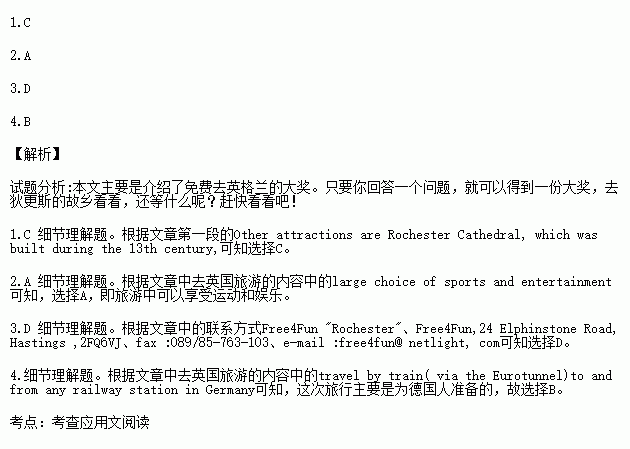题目内容
You still don't know what to do this summer? Well, here's your chance to win a one-week language course in Kent, England! Free4Fun and ETC (English Travel Connections)are giving away two trips to Rochester. This historic city is less than an hour's drive from London and close to the sea resort of Heine Bay. It is also the home of one of England's most famous writers, Charles Dickens. The town of Rochester is in Southeast England. Charles Dickens often wrote about it in his books. His home, Gad's Hill, is there, too. A popular attraction is Rochester Castle, a large Norman fortress (堡垒). It was built in the 11th century and rebuilt during the 14th century. Other attractions are Rochester Cathedral, which was built during the 13th century, and Dickens Centre. It has got its name in honour of Dickens himself.
The trip to England includes:
* travel by train( via the Eurotunnel)to and from any railway station in Germany
* room and full board with a guest family for one week
* language course in small groups
* two trips to London
* large choice of sports and entertainment
* German-speaking advisors available 24 hours a day
Interested? All you have to do is to answer the following question: When was Charles Dickens born?
So, take the chance and send your answer by May 1 to:
Free4Fun "Rochester"
Free4Fun,24 Elphinstone Road, Hastings ,2FQ6VJ
fax :089/85-763-103
e-mail :free4fun@ netlight, com
The two winners will be contacted directly before May 5. They will also be announced in the June issue of Free4Fun.
Good luck!
For further information contact.
phone: (03212) 144-43
fax: (03212) 144-42
e-mail :info@ etc. com
1.Rochester Cathedral was built in the .
A. 1400s B. 1300s C. 1200s D. 1100s
2.What activities can you participate in during the trip?
A. Enjoying sports and entertainment.
B. Learning the German language.
C. Traveling by train with a guest' family.
D. Working as a language advisor.
3. If you want to win a prize you have to send your answer to .
A. the June issue of Free4fun B. ETC
C. info@ etc. com D. free4fun@ netlight, com
4.This advertisement was designed to target .
A. Italians B. Germans
C. Europeans D. Americans

